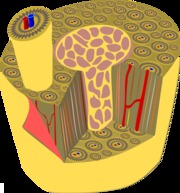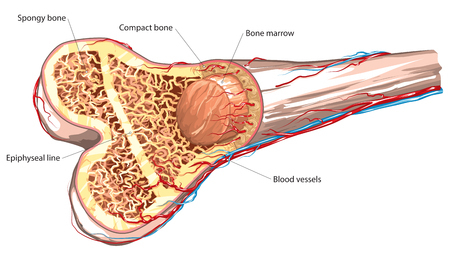Osteomalacia is a disease characterized by soft and weak bones due to poor mineralization. Osteomalacia is not technically the exact same things as rickets, but the two diseases are similar. Rickets is technically the abnormalities in bones resulting from soft bones during childhood. Both are characterized by low levels of Vitamin D and indeed it was in the search for a treatment for rickets that Vitamin D was discovered in the early decades of the 20th Century.
Osteomalacia can be confused with osteopenia from an initial look at the bone. But patient history can easily distinguish the two as osteopenia results from a decline in bone mineralization with age while osteomalacia results from a defect in bone growth with maturization, often due to poor nutition, or from other conditions.
Scientists have identified over 30 causes or comorbid diseases of osteomalacia. Calcium and phosphorus are vital minerals for the growth and maintenance of bones, and vitamin D is a major regulator of bone materials. Deficient diet, intestinal absorption problems, or inability of the body to use these nutrients can cause osteomalacia.
 The body’s primary source of Vitamin D is sunlight; therefore low sunlight exposure is an important cause of osteomalacia. In the US most people get sufficient exposure to sunlight, so osteomalacia is a rare disease. Moreover, dairy products sold for human consumption are rich in calcium, and are often fortified with vitamin D.
The body’s primary source of Vitamin D is sunlight; therefore low sunlight exposure is an important cause of osteomalacia. In the US most people get sufficient exposure to sunlight, so osteomalacia is a rare disease. Moreover, dairy products sold for human consumption are rich in calcium, and are often fortified with vitamin D.
People at risk for developing osteomalacia are:
Occasionally a person’s body cannot use Vitamin D correctly. Other causes for osteomalacia include certain surgeries (gastric or intestinal bypass), celiac disease, kidney or liver disorders, some drugs, and alcoholism. Cancer can also cause osteomalacia.
Completely silent at early stages, osteomalacia causes a number of symptoms as the disease progresses: bone pain, muscle weakness, muscle cramps, numbness or tingling, abnormal heart rate (due to low calcium levels), fatigue, bone deformities, growth problems (in children), and in severe cases, bone fractures.
Doctors choose treatment based on the severity of symptoms and the presence of any underlying diseases or complications.
When the osteomalacia is due to a dietary or sunlight deficiency, supplements of vitamin D and calcium usually cures the condition.
Patients take vitamin D supplements for several weeks or months. These are usually taken orally as pills, although less commonly, doctors administer vitamin D as in injection.
Exposure to sunlight and a diet rich in vitamin D can help prevent osteomalacia. Vitamin D is found in large amounts in fortified dairy products (milk, yogurt), cereal, bread, egg yolks, oily fish (salmon, mackerel, and sardines), and cod liver oil.
Washington University Page on Osteomalacia
Difference Between Osteoporosis, Hyperparathyroidism, and Osteomalacia

